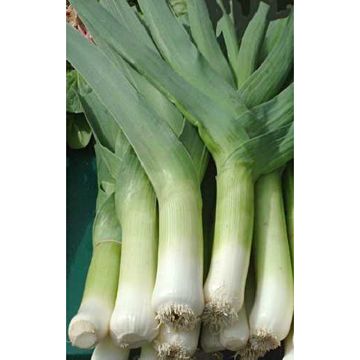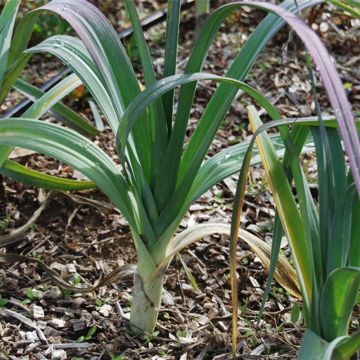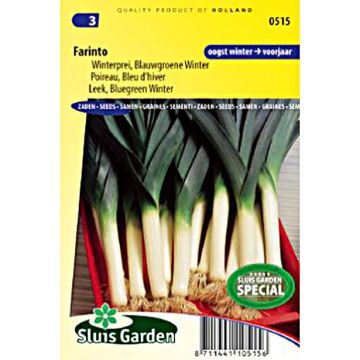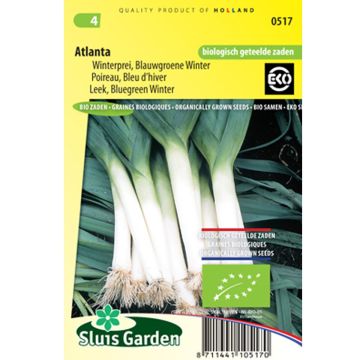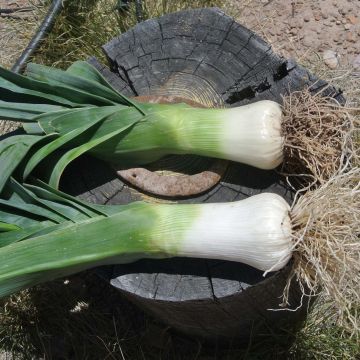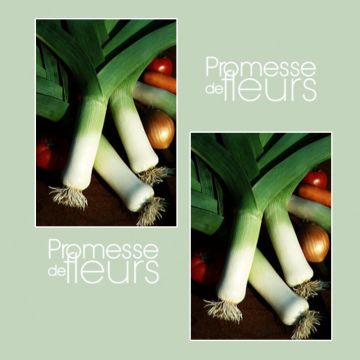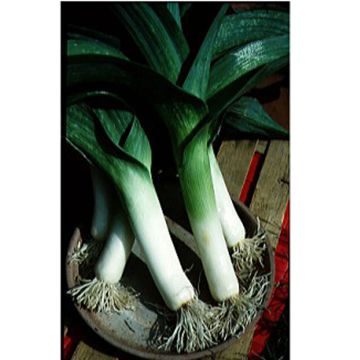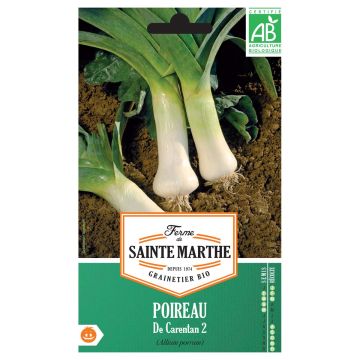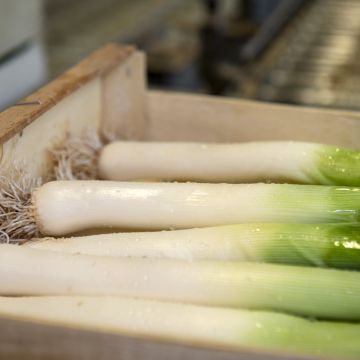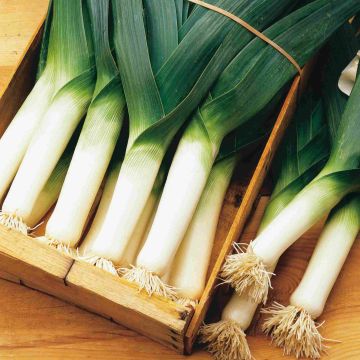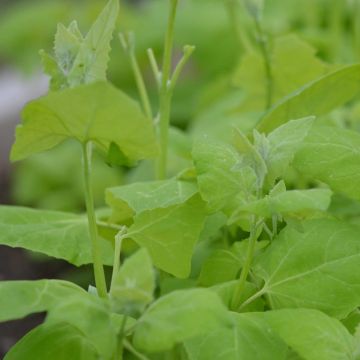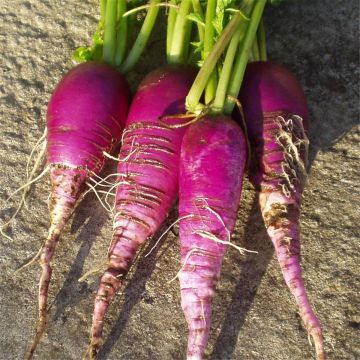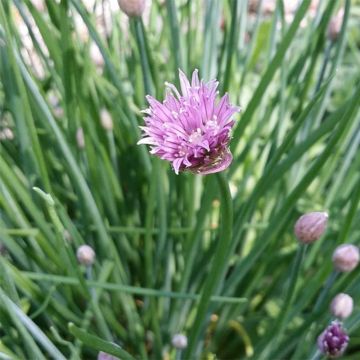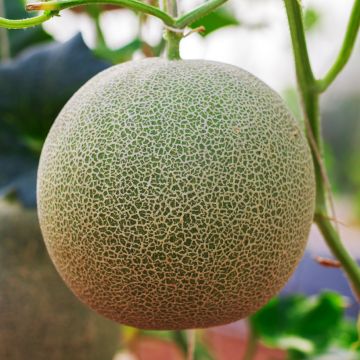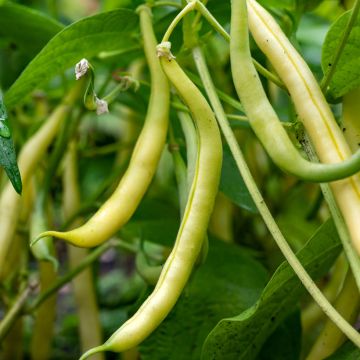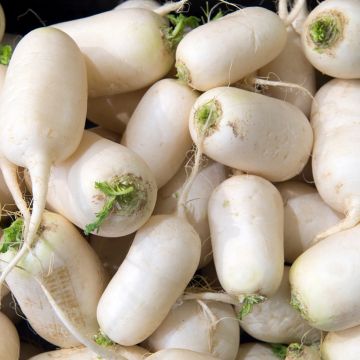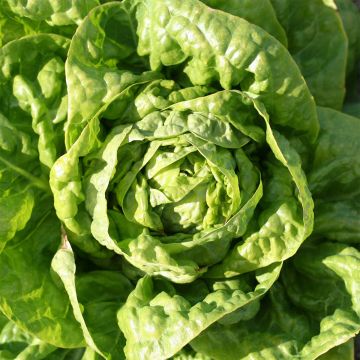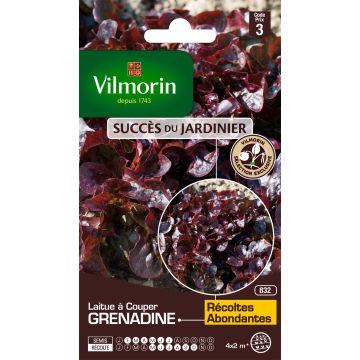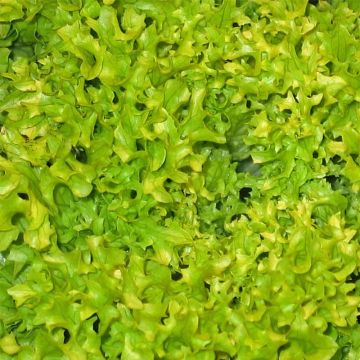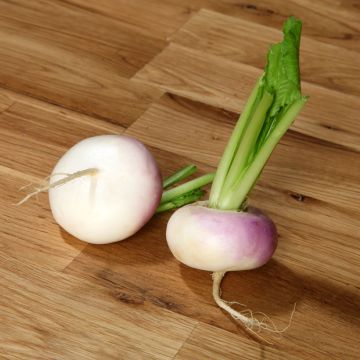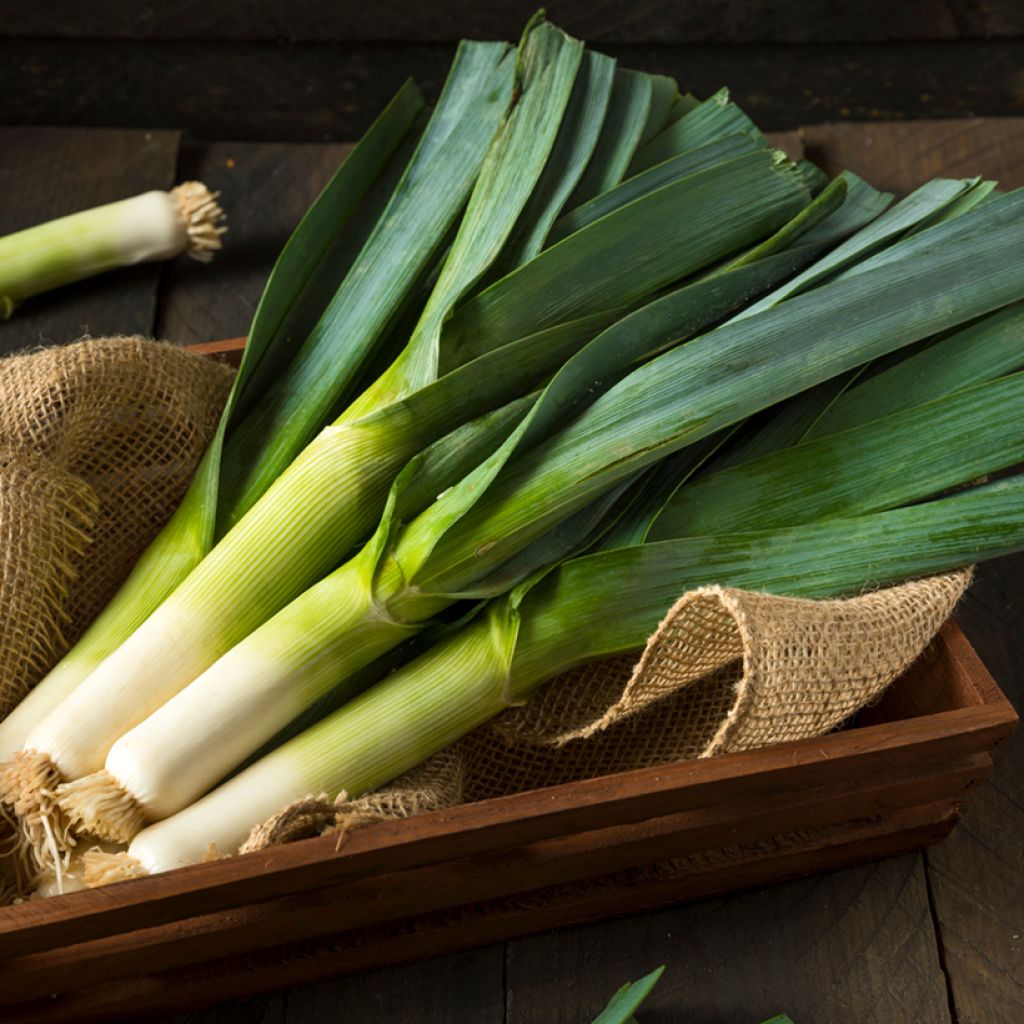

Allium porrum Giant Winter organic seeds - Leek
Leek Giant Winter organic seeds - Allium porrum
Allium porrum Géant d'hiver
Leek
Order in the next for dispatch today!
Dispatch by letter from €3.90.
Delivery charge from €5.90 Oversize package delivery charge from €6.90.
More information
This item is not available in your country.
Schedule delivery date,
and select date in basket
This plant carries a 6 months recovery warranty
More information
We guarantee the quality of our plants for a full growing cycle, and will replace at our expense any plant that fails to recover under normal climatic and planting conditions.
From €5.90 for pickup delivery and €6.90 for home delivery
Express home delivery from €8.90.
Description
The Winter Giant Leek is a very hardy classic winter variety, offered here in the form of certified AB seeds. The plant is rather slim and proud, composed of a very broad bluish-green foliage on an average 25 cm long bole. It is extremely resistant to cold and diseases, well suited for an organic vegetable garden. Even under the snow, it retains its beautiful appearance! This leek is therefore perfect for preparing hearty winter dishes or various vegetable soups.
The Winter Giant Leek is sown from February to April and harvested throughout the winter, from November to March.
The 'Winter Giant' leek is an old French variety, also known as "Du Bouchet". It has been mentioned since 1873, which attests to its age and popularity in French kitchen gardens.
In cooking, the 'Winter Giant' leek captivates with its mild and slightly sweet flavour, which adapts to many winter dishes. It is perfect for making comforting soups for chilly evenings. Its melting texture makes it a choice ingredient for leek fondues, which pair wonderfully with fish, shellfish, and poultry. It is also delicious in pies and gratins, where it harmonises with melting cheeses for generous and tasty dishes. Lastly, it can be cooked with a touch of cream and fresh herbs, a simple yet refined preparation that highlights its delicacy.
The leek, known by the scientific name Allium porrum, is a biennial herbaceous plant belonging to the amaryllidaceae family. Originating from Central Asia, it was already cultivated by the Egyptians over 1500 years before Christ, with long and particularly fine foliage. The Romans also appreciated it, and at that time, it resembled an onion more, with a thin bole and a well-rounded bulb. From the Middle Ages, the leek was widely spread throughout Europe, attesting to its importance in the cultures and kitchen gardens of that time.
The leek presents long blue-green or dark green leaves, wide and sheathing, forming together what is called the bole, meaning the white part resembling a stem. This bole is the most prized part. Its taste is very delicate especially the underground part that has not received light. At the end of the second year, it produces a stalk topped with a spherical purple umbel as big as a tennis ball, which has become the emblem of Wales.
This very hardy vegetable, some winter varieties of which withstand temperatures below -15, even -20°C, can be sown for a large part of the year (February to August). Considered a winter vegetable, it can be harvested almost all year round. The leek is rich in dietary fibres facilitating digestion. It is also rich in vitamins C and B, and in sulphur compounds with antioxidant properties. It also has the reputation, like the onion, of lowering cholesterol levels in the blood among other benefits.
Harvesting: pick your leeks as you need them. The harvest usually takes place between 5 and 8 months after sowing. Gently pull on the leek to avoid damaging or cutting into the bole. You can use a small spade a few cm from the desired leek to lever it out more easily.
Storage: you can keep them for two weeks in the vegetable drawer of your refrigerator. They can be stored for almost 3 months in the freezer. Bag them after blanching them for a few minutes, rinsing them in cold water, then carefully drying them.
Gardener's tip: combine leeks and carrots. The carrot fly dislikes leeks, and the leek fly is not fond of carrots! Tomatoes, lettuces, and strawberries are also good companion plants for leeks, but it dislikes the presence of its cousin the onion, as well as beetroot and beans.
To know if a leek needs watering, just observe its foliage: if it stands tall, all is well, it's not thirsty. If its foliage wilts and leans to the side, it probably needs a sip of water.
Report an error about the product description
Harvest
Plant habit
Foliage
Botanical data
Allium
porrum
Géant d'hiver
Amaryllidaceae
Leek
Cultivar or hybrid
Biennial
Other Leek seeds
Planting and care
The Giant Winter leek is considered a winter vegetable. There are also several summer leeks. The growth cycle of the leek is quite long, occurring in several phases.
Soil preparation: The leek appreciates rich, deep soils highly enriched in organic matter. However, be careful, the soil must have been enriched several months in advance, as our vegetable dislikes too recent amendments. A sunny location in generally moist soil that you have previously dug is preferred.
Sowing: Dig a 2 cm deep furrow and sow sparingly at a rate of one to two seeds every cm. Close the furrow with seed compost and lightly tamp down with a rake. This operation is carried out from February to May under cover depending on the climate (cold frame, tunnel, etc.). Germination will take between fifteen days and three weeks. Once the plant has reached about fifteen cm in height and the thickness of a pencil, it is time to proceed to transplanting. Before that, delicately pull out the young plants and let them dry on the ground in the shade for two days. This operation aims to remove the leek smell and thus avoid attacks from the onion fly.
Transplanting: Before transplanting, dress the leek. "Dressing" means cutting the roots 2 to 3 cm below the bulb and at the same time cutting the young leaves a few cm above the bole. The goal is twofold: removing the roots allows for better rooting by stimulating it and cutting the leaves prevents too rapid evaporation.
Then, prepare holes about fifteen cm deep spaced 15 to 20 cm apart in all directions. Insert your young plants into them. The white part must be entirely buried. Water generously with a watering can which will close the holes around the leek boles. They need a soil rich in nitrogen. You can place freshly mown grass between the rows. After a period ranging from fifteen days to a month, the plants grow and strengthen. Then, earth them up to keep the bole as much as possible out of the light to keep it white and tender.
Clumping: There are summer varieties and winter varieties depending on their hardiness and the period when leeks should be sown. Sow in autumn to be harvested in spring. This means that some of them will spend the winter outside. In regions with harsh winters, it is sometimes necessary to plan for clumping leeks, that is, to gather them in a place protected from the wind and plant them temporarily before transplanting to their final place in spring.
Seedlings
Care
Intended location
This item has not been reviewed yet - be the first to leave a review about it.
Vegetable seeds
Haven't found what you were looking for?
Hardiness is the lowest winter temperature a plant can endure without suffering serious damage or even dying. However, hardiness is affected by location (a sheltered area, such as a patio), protection (winter cover) and soil type (hardiness is improved by well-drained soil).

Photo Sharing Terms & Conditions
In order to encourage gardeners to interact and share their experiences, Promesse de fleurs offers various media enabling content to be uploaded onto its Site - in particular via the ‘Photo sharing’ module.
The User agrees to refrain from:
- Posting any content that is illegal, prejudicial, insulting, racist, inciteful to hatred, revisionist, contrary to public decency, that infringes on privacy or on the privacy rights of third parties, in particular the publicity rights of persons and goods, intellectual property rights, or the right to privacy.
- Submitting content on behalf of a third party;
- Impersonate the identity of a third party and/or publish any personal information about a third party;
In general, the User undertakes to refrain from any unethical behaviour.
All Content (in particular text, comments, files, images, photos, videos, creative works, etc.), which may be subject to property or intellectual property rights, image or other private rights, shall remain the property of the User, subject to the limited rights granted by the terms of the licence granted by Promesse de fleurs as stated below. Users are at liberty to publish or not to publish such Content on the Site, notably via the ‘Photo Sharing’ facility, and accept that this Content shall be made public and freely accessible, notably on the Internet.
Users further acknowledge, undertake to have ,and guarantee that they hold all necessary rights and permissions to publish such material on the Site, in particular with regard to the legislation in force pertaining to any privacy, property, intellectual property, image, or contractual rights, or rights of any other nature. By publishing such Content on the Site, Users acknowledge accepting full liability as publishers of the Content within the meaning of the law, and grant Promesse de fleurs, free of charge, an inclusive, worldwide licence for the said Content for the entire duration of its publication, including all reproduction, representation, up/downloading, displaying, performing, transmission, and storage rights.
Users also grant permission for their name to be linked to the Content and accept that this link may not always be made available.
By engaging in posting material, Users consent to their Content becoming automatically accessible on the Internet, in particular on other sites and/or blogs and/or web pages of the Promesse de fleurs site, including in particular social pages and the Promesse de fleurs catalogue.
Users may secure the removal of entrusted content free of charge by issuing a simple request via our contact form.
The flowering period indicated on our website applies to countries and regions located in USDA zone 8 (France, the United Kingdom, Ireland, the Netherlands, etc.)
It will vary according to where you live:
- In zones 9 to 10 (Italy, Spain, Greece, etc.), flowering will occur about 2 to 4 weeks earlier.
- In zones 6 to 7 (Germany, Poland, Slovenia, and lower mountainous regions), flowering will be delayed by 2 to 3 weeks.
- In zone 5 (Central Europe, Scandinavia), blooming will be delayed by 3 to 5 weeks.
In temperate climates, pruning of spring-flowering shrubs (forsythia, spireas, etc.) should be done just after flowering.
Pruning of summer-flowering shrubs (Indian Lilac, Perovskia, etc.) can be done in winter or spring.
In cold regions as well as with frost-sensitive plants, avoid pruning too early when severe frosts may still occur.
The planting period indicated on our website applies to countries and regions located in USDA zone 8 (France, United Kingdom, Ireland, Netherlands).
It will vary according to where you live:
- In Mediterranean zones (Marseille, Madrid, Milan, etc.), autumn and winter are the best planting periods.
- In continental zones (Strasbourg, Munich, Vienna, etc.), delay planting by 2 to 3 weeks in spring and bring it forward by 2 to 4 weeks in autumn.
- In mountainous regions (the Alps, Pyrenees, Carpathians, etc.), it is best to plant in late spring (May-June) or late summer (August-September).
The harvesting period indicated on our website applies to countries and regions in USDA zone 8 (France, England, Ireland, the Netherlands).
In colder areas (Scandinavia, Poland, Austria...) fruit and vegetable harvests are likely to be delayed by 3-4 weeks.
In warmer areas (Italy, Spain, Greece, etc.), harvesting will probably take place earlier, depending on weather conditions.
The sowing periods indicated on our website apply to countries and regions within USDA Zone 8 (France, UK, Ireland, Netherlands).
In colder areas (Scandinavia, Poland, Austria...), delay any outdoor sowing by 3-4 weeks, or sow under glass.
In warmer climes (Italy, Spain, Greece, etc.), bring outdoor sowing forward by a few weeks.


































